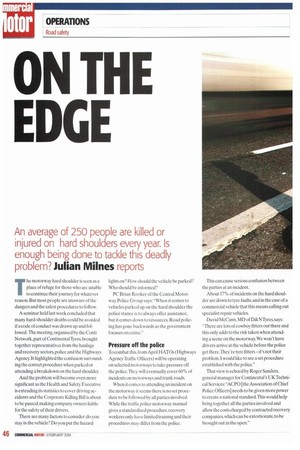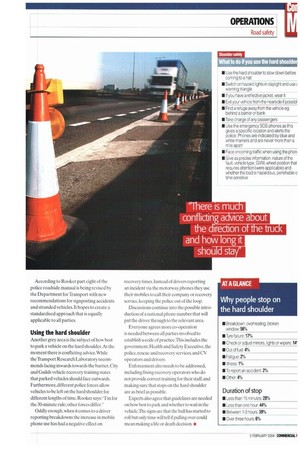ON THE EDGE
Page 48

Page 49

If you've noticed an error in this article please click here to report it so we can fix it.
An average of 250 people are killed or injured on hard shoulders every year. Is enough being done to tackle this deadly
problem? Julian MilInes reports The motorway hard shoulder is seen as a place of refuge for those who are unable to continue their journey for whatever reason. But most people are unaware of the dangers and the safest procedures to follow.
A seminar held last week concluded that many hard-shoulder deaths could be avoided if a code of conduct was drawn up and followed. The meeting. organised by the Conti Network, part of Continental Tyres, brought together representatives from the haulage and recovery sectors, police and the Highways Agency. It highlighted the confusion surrounding the correct procedure when parked or attending a breakdown on the hard shoulder.
And the problem will become even more significant as the Health and Safety Executive is extending its statistics to cover driving accidents and the Corporate Killing Bill is about to be passed.making company owners liable for the safety of their drivers.
There are many factors to consider: do you stay in the vehicle? Do you put the hazard lights on? How should the vehicle be parked? Who should be informed?
PC Brian Rooker of the Central Motorway Police Group says:"When it comes to vehicles parked up on the hard shoulder the police stance is to always offer assistance. but it comes down to resources. Road policing has gone backwards as the government focuses on crime."
Pressure off the police
lb combat this, from April HATOs (Highways Agency Traffic Officers) will he operating on selected motorways to take pressure off the police.They will eventually cover 60% of incidents on motorways and trunk roads.
When it comes to attending an incident on the motorway it seems there is no set procedure to be followed by all parties involved. While the traffic police motorway manual gives a standardised procedure, recovery workers only have limited training and their procedures may differ from the police. This can cause serious confusion between the parties at an incident.
About 17% of incidents on the hard shoulder are down to tyre faults, and in the case of a commercial vehicle that this means calling out specialist repair vehicles.
David McCann, MD of D&N Tyres, says: "There are lots of cowboy fitters out there and this only adds to the risk taken when attending a scene on the motorway. We won't have drivers arrive at the vehicle before the police get there.They're tyre fittersit's not their problem.! would like to see a set procedure established with the police."
That view is echoed by Roger Sanders. general manager for Continental's UKTechnical Services:-ACP0 [the Association of Chief Police Officers] needs to be given more power to create a national standard:This would help bring together all the parties involved and allow the costs charged by contracted recovery companies, which can be extortionate, to be brought out in the open." According to Rooker part eight of the police roadside manual is being revised by the Department for Transport with new recommendations for signposting accidents and stranded vehicles. It hopes to create a standardised approach that is equally applicable to all parties.
Using the hard shoulder Another grey area is the subject of how best to park a vehicle on the hard shoulder. At the moment there is conflicting advice. While the Transport Research Laboratory recommends facing inwards towards the barrier, City and Guilds vehicle recovery training states that parked vehicles should face outwards. Furthermore,different police forces allow vehicles to be left on the hard shoulder for different lengths of time. Rooker says:"I'm for the 30-minute rule: other forces differ.
Oddly enough. when it comes to a driver reporting breakdowns the increase in mobile phone use has had a negative effect on recovery times. Instead of drivers reporting an incident via the motorway phones they use their mobiles to call their company or recovery service, keeping the police out of the loop.
Discussions continue into the possible introduction of a national phone number that will put the driver through to the relevant area.
Everyone agrees more co-operation is needed between all parties involved to establish a code of practice. This includes the government. Health and Safety Executive, the police, rescue and recovery services. and CV operators and drivers.
Enforcement also needs lobe addressed, including fining recovery operators who do not provide correct training for their staff and making sure that stops on the hard shoulder are as brief as possible.
Experts also agree that guidelines are needed on how best to park and whether to wait in the vehicle.The signs are that the ball has started to roll but only time will tell if pulling over could mean making a life or death decision. •


































































































































































































